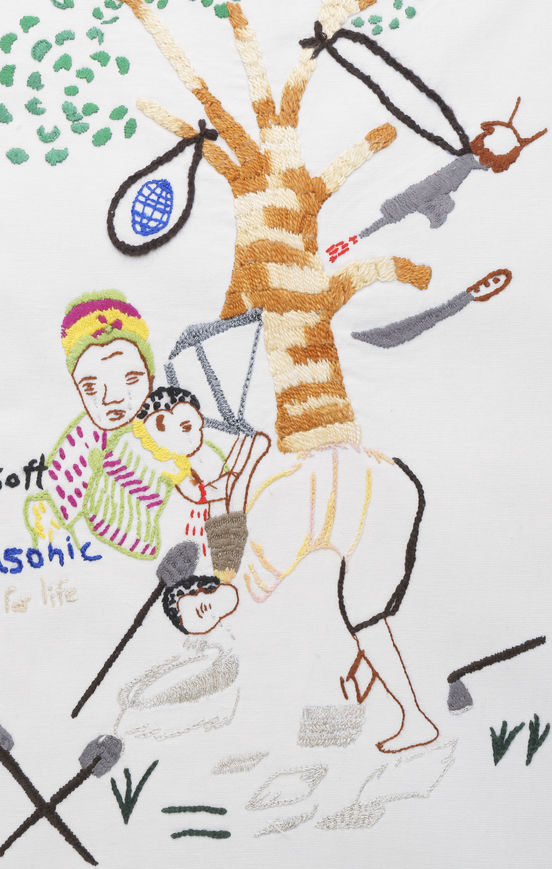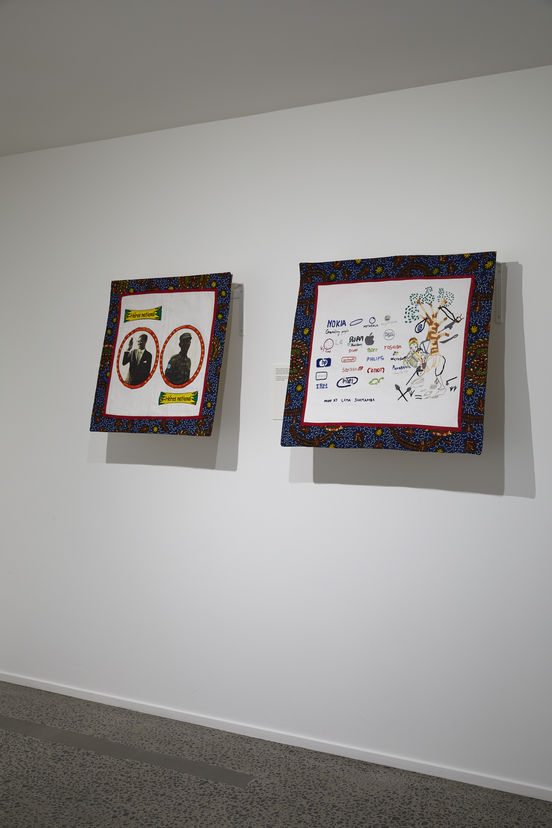Mulame is the first solo exhibition by Lema Shamamba, a community leader, educator, mother and storyteller who arrived in Aotearoa New Zealand in 2009 as a refugee from the Democratic Republic of the Congo (DRC).
The ‘medium as message’ takes on new meaning through Shamamba’s unique storytelling process developed to overcome language barriers during her initial resettlement in New Zealand. Shamamba’s memories manifest into written story, then into drawings and finally into embroidered textiles set within the Congo landscape. She has relied on all three creative mediums as a means of embodying messages, histories and identities of DRC.
Although small in scale, Shamamba’s embroidered narratives are potent in their depiction of the ongoing conflicts in the Congo. Conflict over rich natural minerals is represented through metallic coloured forms whilst semi-figurative characters illustrate the daily threat of being killed or raped by militias holding rifles and, in some works, figures are shown attempting crossing the border. Within these graphic retellings, Shamamba also offers counter imagery such as the DRC flag that has been reconfigured as the ‘sun’ within her landscapes and act as symbols of hope that embody her resilient stance: “the beauty of Congo can light up the whole world.”
Shamamba extends textile narratives into films focused on economic activities, education and the ongoing needs of the DRC. In the film Education, children dance to the song Mulame, its meaning embedded within the Kihunde dialect and translates to mean ‘be there forever.’ This sentiment reaches across the exhibition and acknowledges the continued resilience of the people of the Democratic Republic of Congo.
--
Lema Shamamba was born and raised in Bweremana, a district of Masisi in the eastern territory of the Democratic Republic of Congo. There are more than 200 Congolese ethnic groups in the DRC and her family is Hunde, the indigenous people of Masisi district. In her local community in West Auckland, she is known affectionately as ‘Mama Lema’ and has worked closely with the Ranui Action Project to reduce the isolation that refugee migrant families often experience.
In 2014, Shamamba established the group Women of Hope that connects migrant women by coordinating activities such as crafting, growing indigenous foods in the community gardens, playgroups for Swahili-speaking children as well as driver license training. More recently, Shamamba was recognised for her work as a community leader in Women Kind: New Zealand Women Making a Difference, an extensive publication that celebrates the success of New Zealand women and includes former Prime Minister Helen Clark ONZ SSI PC as well as artist Lisa Reihana MNZM.
Ane Tonga is an artist and curator currently based in Auckland, New Zealand.
As a curator, Ane has undertaken curatorial roles at Dunedin Public Art Gallery, Dowse Art Museum, Museum of New Zealand Te Papa Tongarewa and was formerly the Lead Exhibition Curator at Rotorua Museum Te Whare Taonga o Te Arawa. She was the Judge of the 2016 Miles Art Awards at Tauranga Art Gallery and Judge of the 2017 Estuary Art and Ecology Prize at Malcolm Smith Gallery. She has held academic positions including Adjunct Lecturer at Unitec Institute of Technology and was a Professional Teaching Fellow at Elam School of Fine Arts at the University of Auckland. Ane has also written for numerous art publications and catalogues on artists which include Mata Aho Collective, Jasmine Togo-Brisby, Amie Siegel, The Pacific Sisters and recently published the monograph, Te Ringa Rehe - The Legacy of Emily Schuster.

Lema Shamamba, Mulame, 2019. Image: Haru Sameshima.

Lema Shamamba, Mulame. Image: Samuel Hartnett.

Lema Shamamba, Mulame, 2019. Image: Samuel Hartnett.